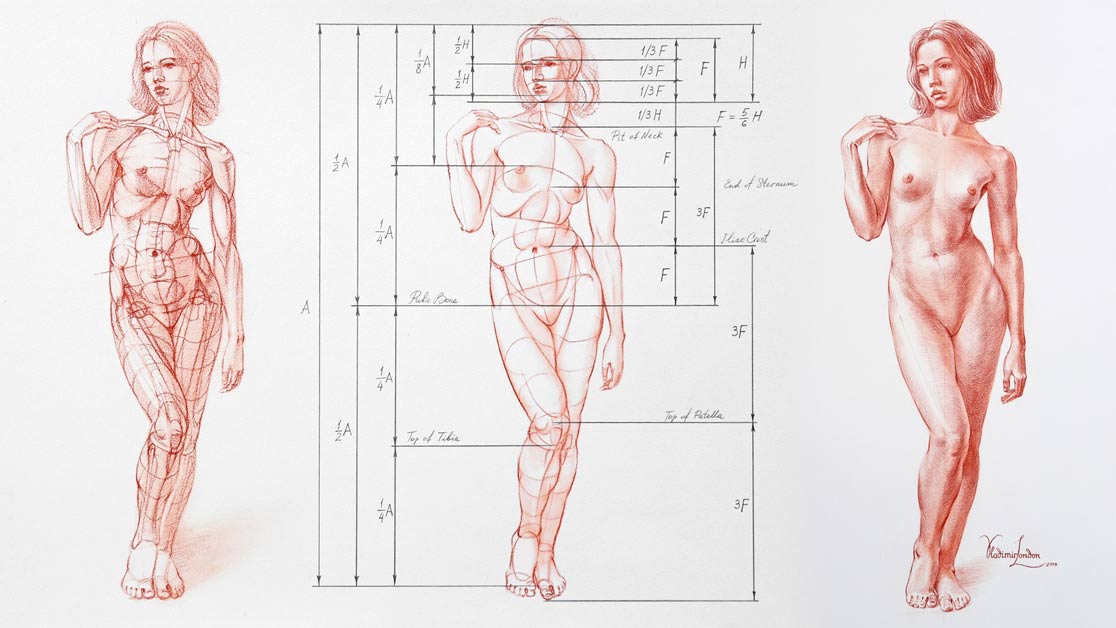Human Body Proportions in Contrapposto
Enroll in the Life Drawing Academy now!
Human Body Proportions in Contrapposto
By Vladimir London
In this video lesson, you will discover how to draw a female figure standing in contrapposto with the necessary knowledge of a human body proportions.
First, I will do a quick five-minute sketch, and then we will spend more time on proportions.
Let's begin with proportions.

The middle of a figure coincides with the pubic bone.
I mark the figure's height as "A". Half of the figure is one-half of "A".
Each half is halved again. One-fourth of "A" coincides with the knee level and the breast line level.
The top quarter is halved again. This gives one-eighth of the figure's height.
The height of the head, marked as "H", is slightly bigger than one-eighth. The head fits seven and a half times into the dimension "A".
The height of the face, marked as "F", is five-sixths of the head's height.
The head's height divided in half gives the level of the eyes.
The height of the face can be divided into three equal parts—this locates the level of the eyebrows and the base of the nose.
The distance from the pit of the neck to the chin fits three times into the head's height.
The height of the face fits three times into the distance from the pit of the neck to the pubic bone.
The height of the face is equal to:
- the height of the breastbone
- the distance from the breastbone to the navel; and
- from the navel to the pubic bone
The distance from the pit of the neck to the pubic bone is comparable to the distance from toes to the top of the kneecap, and from the kneecap to the navel or top of the pelvis.
These proportions are easy to keep in mind and use for drawing standing figures from life. There are some other proportions, which we will explore later.
I often receive comments from Academy students that some proportions do not work for their models. That's how it supposed to be. All people are different; should we all have exactly the same proportions, everyone would look the same.
Canons of proportions are idealized measurements that you may use to see how your model deviates from those rules. Also, there are different canons developed by various artists, sculptors and architects during the history of arts. Certain proportions can vary from canon to canon.
The steps of drawing you see in this lesson are not what you have to do every time you draw a model from life. However, such constructive drawing is what you need to keep in mind every time you sketch a figure.
Before using rules of constructive drawing becomes your second nature, so you can draw figures on autopilot, I would advise you to draw on paper helpful constructive drawing lines, such as axes, bones, muscles, proportions, and contours. All these will help you to depict the correct outlines of the figure. This is what will differentiate you from a beginner, who draws only outlines with no knowledge where to put them.
With time and practice, you will gradually memorize the necessary rules and proportions, and this will enable you to draw figures from life, memory, and imagination realistically.
As you see in this lesson, the knowledge of proportions and anatomy helps to build a figure step by step. Even though I draw this figure from life, a model is actually secondary to the knowledge I am using in drawing. I can do contrapposto pose from memory or imagination, as I have done it hundreds of times in short sketches and long studies from life.
How to draw a portrait is big topic on its own, and therefore you will learn it in many other video lessons of the Life Drawing Academy course.
Here is what we want you to do in this course — to learn the main principles of how a figure is constructed and how to use proportions and anatomy. With such knowledge, your life drawing skills will rise to the next level.
I hope you have learned a thing or two about proportions in contrapposto. Because this topic is so important in life drawing, there are more videos in this course to cover it in depth.
To learn good drawing techniques, enroll in the Life Drawing Academy course:
Online Course
A self-study, self-paced course for you to learn fundamental methods of classical drawing and improve life drawing skills by watching video lessons and doing assignments
- Unlimited access to 52 life drawing video lessons
- Lifetime membership without deadlines
- Unlimited support from the Academy tutors
- Constructive critique of your artworks
- Member access to the Academy's Art community
- Place in the Academy's Students Gallery
- Exclusive members-only newsletter and bonuses
- Life Drawing Academy Diploma of Excellence in your name
One-time payment - Lifetime membership
$297 USD
Personal Tutoring Online + Online Course
The ultimate choice if you who would like to receive personal, one-to-one tutoring from the Academy teachers, which is custom-tailored to your skills and needs
- Everything in Online Course, plus:
- Dedicated team of art tutors
- Assessment of your current level of drawing skills
- Personalized curriculum tailored to your skills and goals
- Up to 100 drawing tasks with by-task assessment
- Unlimited one-to-one personal coaching with detailed per-task instructions and feedback
- Artwork critiques and results-oriented guidance
One-time payment - Lifetime membership
$997 USD




